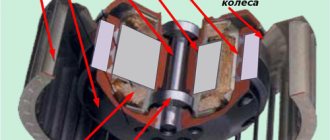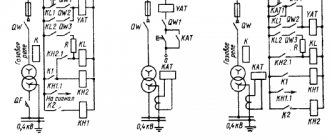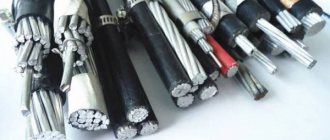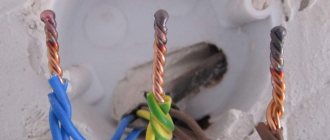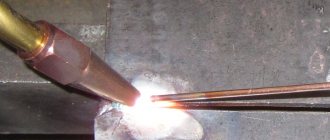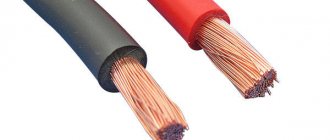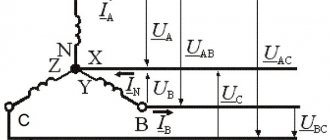Winding wire is a general collective term used to refer to electrical products. Like other types of such products, its main purpose is to ensure a safe connection between an electrical source and an electrical circuit or consuming device. There are many types of electrical wires, which is easily explained by the variability in electricity use. The use of this type of cable products is in the winding of coils of energy generators, transformers and special devices.
What it is
In modern reality it is impossible to do without electricity. It reaches the consumer from a source that transmits or generates it. Multidisciplinary use naturally includes many types that provide functionality. Therefore, the variety of cable products amazes the imagination of an amateur. There are output and connecting wires, automobile and aviation wires, communication wires and those designed for installing overhead lines. What they have in common is the name (wire) and the letter P in the marking, indicating that the electrical product belongs to a certain category of wires.
Winding material spools
The two most common categories are winding and installation wire. As one would expect from the name, winding types are used for winding: in coils, transformers, electric motors and electric generators, electromagnets, armatures of commutator machines, devices, devices. This is a specific number of turns of wire used to create an electrical circuit. The dimensions, purpose, and place of application of the devices are varied. Hence the huge number of types of winding wires, their variability, and the impossibility of differentiating an electrical product based on one characteristic.
An approximate classification can be made according to the following features:
- the number of current-carrying cores (from one to several, usually called multi-core, with a number of more than three);
- the material used to manufacture the cores for conducting current - made of copper, aluminum or combined alloys (nichrome, made of nickel and chromium);
- cross-section geometry - the wire in cross-section can be round or rectangular;
- insulation material - fibrous, enamel, combined, usually consisting of several layers of insulating coating of different types).
Note! All features of the material, its characteristics, are reflected in the marking. Technical information indicates the type of product (P - wire), the first letter of the abbreviation, copper or aluminum made of an alloy, the wire is indicated at the end of a series of letters (A - aluminum, NX - nichrome). There is a whole list of abbreviations indicating the material used to make the insulating layer.
You may be interested in Determining the wire cross-section
Aluminum winding wire
Copper wire for rewinding is used more often than others. The prevalence of aluminum, which is cheaper, is hampered by its resistivity, which is noticeably higher than the similar properties of copper. Combined alloys are used for special needs created by the specific complexity of devices and the functions they perform.
Winding
Winding wires have been around us since the invention of the electric motor, and although their main purpose has not changed - converting mechanical energy into electrical energy and vice versa - they have changed significantly in recent years.
Winding wires are made of single-core wires, usually of copper and much less often of aluminum, round and rectangular cross-section, with enamel, paper, fiberglass and other insulation that protects the wire from short circuits. Often, winding wires have several layers of insulation, for example, a layer of enamel covered with a layer of silk, cotton yarn, polyethylene, or others. When using one type of insulation, it is impossible to obtain all the necessary properties at once, so a two-layer design began to be used in winding wires. So, for example, the first layer of insulation provides high electrical and physical properties of the wire, and the second layer provides high mechanical strength or resistance to aggressive environments. The most widely used are round copper winding wires with enamel insulation.
Reduction in size is a dominant process in the evolution of technology, and electrical engineering and instrument making are no exception. Winding wires are becoming one of the components of miniaturization of technology and in their development they are one step ahead of everyone else. Of particular importance today are the insulating materials used to cover copper or aluminum wires. Smaller gauge wires must have the same properties as their predecessors, so the insulation must withstand much higher temperatures (for example: 200°C, versus 155°C a decade ago for enameled wires).
The history of the production of winding wires at Kamkabel OJSC dates back to October 1968, when the first batch of PSD brand wires was produced. Since then, the company has mastered the production of more than 30 types of winding wires. Every year Kamkabel produces more than 5 thousand tons of winding wires and ranks 3rd among manufacturers in the CIS countries. Today Kamkabel offers its customers wires with a diameter from 0.020 to 8,000 mm and a rectangular cross-section up to 100 sq. mm.
The highest quality of products is achieved through the use of advanced technologies, the use of high-precision control and measuring instruments, as well as special attention to the selection of materials.
Why is it needed?
The scope of application of the cable is the creation of turns of an electrical circuit for the summation of electromotive forces. Depending on the device, the winding can be simple or complex, consisting of many sections and layers. which are separated by insulation. Hence the numerous types of winding wires and the wide scope of their everyday use:
- electric generators and electric motors, with three-phase, single-phase, short-circuited, armature or excitation windings;
- electromagnets, inductors;
- transformers, divided into primary and secondary, as well as auxiliary - for supplying and discharging energy, power compensation.
Additional information! The simplest example of such a device is a coil. However, even if we do not take into account the field and short-circuit windings used in asynchronous motors, there are much more complex circuits. These include, for example, the end one, for recording which diagrams are used, or the unfolded one, with a cylinder of the plane of rotation.
Comparative characteristics of metals
| STATEMENT | IS IT TRUE | MYTH |
| Aluminum wound transformer terminations are not compatible with copper line and power cables. | X | |
| Terminating leads properly is a more difficult task for aluminum wound transformers. | X | |
| The connections to the line and load of transformers with copper windings are more reliable than those of transformers with aluminum windings. | X | |
| Transformers with aluminum windings weigh lighter than those with copper windings. | X | |
| Copper wound low voltage transformer windings are better suited for shock loads because copper has higher tensile strength than aluminum. | X | |
| Transformers with aluminum windings have higher losses than those with copper windings. | X |
The debate about which metal is best to use for transformer windings has not stopped for many years. Opponents, who make different technical arguments in favor of different metals, constantly change their views. Most of the arguments are not that significant, and some of the so-called facts are outright misinformation.
In order to choose the right material for the winding of the converter, a comparative analysis of the operating parameters of aluminum and copper should be performed and the degree of their difference should be determined. Attention is paid to those parameters that cause the most concern, since they are the most important in the operation of the converting device.
Characteristics
Enameled or enamel-insulated wire can be filled with aluminum, copper or nickel-plated copper. Usually these are electrical products that are resistant to heat, the coating of which is made using electrical insulating varnishes. Special polymer compounds dissolve in easily evaporating organic compounds. When heated, the solvent evaporates, which gives high-strength enameling - the formation of a stable and hard film on the wire. Viniflex, metalvin, polyetherimide varnishes, drying natural oils, and synthetic resins can be used in the manufacture of enamel wire. Double-layer insulation is made by applying two layers of varnish.
Double-layer insulated winding wire
The characteristics of winding wires with enamel insulation can be determined by the filling and cross-sectional shape (round or rectangular), outer diameter, and ability to withstand mechanical load. Aluminum wires are tested for breakdown voltage, and copper wires are tested for elasticity, resistance to insulation abrasion and the maximum number of microdefects.
Subtleties of choosing a winding wire
When choosing a product brand, the following criteria should be taken into account:
- Required heat resistance class. Wires with enamel insulation are not suitable for windings with high rotation speeds, since temperatures above 160 - 170 degrees Celsius can melt the protective layer.
- Permitted thickness of the insulating layer. Combined and fiber insulation have the greatest thickness of wire insulation. However, their use in conditions of high humidity is undesirable.
- Requirements for the required level of mechanical strength, moisture resistance, frost resistance and protection from chemicals.
Structure
It is diverse, since many varieties fall under the category of electrical products used for winding:
- standard and simple consists of a conductive core and an insulating layer (the material for making the wire, like the raw materials for insulation, can be variable);
- bare wire is made without insulation;
- stranded is made of several wires twisted together;
- stranded consists of several conductive wires, but each of them is isolated from its neighbors, and then from the totality of its components.
You may be interested in this Description of the network cable
Important! Its intended purpose and scope of application depend on the structure of the winding material. Working with each variety has its own specific difficulties. In order to wrap the device being manufactured and connect the individual elements together, you need to have certain knowledge about the type of energy used in the equipment and how to isolate the connection points to comply with safety regulations.
General idea of wire structure
Purpose of the wire
Unlike mounting and installation products, the winding product is used only for certain purposes. Moreover, each category is used depending on the technical characteristics - the material of the conductors, the type of insulation used, physical and mechanical characteristics and heat resistance. Types of wire depending on its purpose:
- PEL - copper, insulated with oil varnishes, used in electrical appliances - for the manufacture of frames and coils;
- in radio engineering and industrial instrument making, products with an enamel coating and high resistance to external aggressiveness and electrical insulating properties are often needed;
- wires with fiber or combined insulation are intended for electric motors and other devices in which there is a possibility of excessive mechanical stress, but the thickness of the insulating layer does not matter.
The need to independently rewind a certain part in a device means for a repairman or radio amateur a careful selection of the necessary material according to the manufacturer’s markings and technical regulations.
Types of winding wire
High Frequency Winding Wire
The main nuance in choosing a winding wire is the frequency of the current flowing through it. In the case of basic values of alternating current with a frequency of 50 Hz or direct current, the flow of ordered particles through the winding conductors occurs in a normal, uniform manner.
As soon as the frequency of current flow increases, a displacement of the flow of charged particles begins. At the same time, electrons begin their movement along the outer layer of the conductor. In addition, in the case of increased current frequency, the resistance to current flow and heating of the winding increases.
Taking into account all the physical factors, for the manufacture of windings for equipment with a high frequency of electric current flow, a number of measures are used to help equalize all the factors that ensure the operation of such equipment. Winding of the winding wire is carried out using the “bundle” method from many stranded insulated wires.
In this case, the higher the frequency of the current in the equipment, the smaller the diameter of the winding wire should be.
How to use winding wire correctly
Electrical installation work in modeling, radio electronics and even robotics, as well as in repair work to restore devices of various types, involves the use of variable methods to ensure safety. A repairman or radio amateur can use various techniques - soldering and terminal crimping, sleeve crimping and even bolting.
Working with the winding wire is carried out with special devices:
- To remove a conventional type of dielectric, a sharp cutting tool is used;
- There are different types of enamel coating, some of which do not require removal of the insulating layer: it melts during soldering;
- to cut and transform live wires and carry them to the soldering iron, you will need manipulators (nippers or tweezers);
- solder heating devices are needed - local or local - soldering irons, crucibles, furnaces in industrial conditions to wire large cross-sections or volumetric parts.
The correct implementation of repair or winding work is determined by several circumstances - the type of device, cross-sectional diagram, number of turns of the winding. Fluxes or solders must be selected according to several characteristics and correspond to the marking of the wire. Copper, aluminum and composite strands may require different solders. Not only the chemical composition and refractoriness matter, but also the electrical properties.
You might be interested in this: Connecting cables with a coupling
Markings and types of copper winding wires
Copper winding wires are used for the windings of transformers, chokes, electromagnetic relays, and coils of oscillating circuits. The diameter of the wire is determined by current density, winding resistance, considerations of winding convenience and reliability. Very thin wires (less than 0.07 mm in diameter) are not as reliable, are much more expensive and make winding more difficult.
The type of wire insulation is selected depending on the operating temperature of the winding, the required electrical strength, and the permissible fill factor of the magnetic circuit window.
In devices and transformers of semiconductor equipment intended for operation under normal conditions, wires in enamel insulation (grades PEL, PEV, etc.) are usually used. If there are high requirements for equipment reliability, wires with double-layer insulation (PEV-2, PEVTL-2, PELR-2, etc.) are recommended.
Wires with combined insulation are used under increased mechanical loads during winding or operation of equipment. PEVTL brand wires are characterized by relatively high resistance to heat and high insulation resistance. They can be tinned by immersing them in molten solder, or using a soldering iron without prior stripping or using fluxes.
For the manufacture of frameless windings, LDPE wires with an additional thermoplastic coating of polyvinyl acetate-based varnishes are used. But remember that when heated to a temperature of 160-170 ° C for 3-4 hours, the turns stick together.
Wires can be coated (insulated) with enamel, fibrous materials, or a combination. Enamel has better electrical insulating properties than fibrous materials; in addition, the diameter of enamel wires is much smaller. The electrical insulating properties of nylon fiber and natural silk are slightly higher than those of cotton fiber.
Nylon fiber is superior to natural silk in terms of resistance to abrasion and solvents (gasoline, benzene, mineral oils, etc.).
Table 1. Main characteristics of copper winding wires, types of insulation, permissible temperature and core diameter.
| Wire brand | Insulation characteristics | Maximum permissible temperature, C | Diameter of copper core, mm |
| PKR-1 | Wire with continuous nylon insulation | 105 | 0,72 — 2,44 |
| PKR-2 | Wire with continuous thickened nylon insulation | 105 | 0,72 — 2,44 |
| PLBD | Wire with winding made of Lavsan silk and cotton yarn in two layers | 105 | 0,38 — 4,10 |
| PLD | Wire with Lavsan silk winding in two layers | 120 | 0,38 — 1,30 |
| PSD | Wire with fiberglass winding in two layers with gluing and impregnation with heat-resistant varnish | 155 | 0,31 — 4,80 |
| PSDK | Wire with fiberglass winding in two layers with gluing and impregnation with Organosilicon varnish | 180 | 0,31 — 4,80 |
| PSDCT | Wire with fiberglass winding in two layers, glued and impregnated with Organosilicon varnish, Heat-resistant | 300 | 0,31 — 1,56 |
| PEV | Wire insulated with high-strength enamel coating | 105 | 0,02 — 0,05 |
| PEV-1 | Wire insulated with high-strength enamel coating one layer | 105 | 0,06 — 0,47 |
| PEV-2 | Wire insulated with two layers of high-strength enamel coating | 105 | 0,06 — 0,47 |
| LDPE | Wire insulated with one layer of high-strength enamel with additional thermoplastic coating | 105 | 0,2 — 0,5 |
| PEVCL | Wire insulated with high-strength enamel coating based on nylon varnish | 105 | 0,1 — 0,15 |
| PEVLO | Wire insulated with high-strength enamel coating and single-layer Lavsan silk winding | 105 | 0,06 — 1,3 |
| PETVL-1 | Wire insulated with a high-strength heat-resistant enamel coating in one layer based on polyurethane varnish (the wire is tinned without preliminary stripping of the enamel and without the use of etching compounds) | 120 | 0,06 — 1,56 |
| PETVL-2 | Wire insulated with a high-strength heat-resistant enamel coating in two layers based on polyurethane varnish (the wire is tinned without preliminary stripping of the enamel and without the use of etching compounds) | 120 | 0,06 — 1,56 |
| PEL | Wire with enamel varnish-resistant coating | 90 | 0,03 — 2,44 |
| PELCO | Wire with enamel varnish-resistant coating and single-layer nylon fiber winding | 105 | 0,2 — 2,10 |
| PELO | Wire with enamel varnish-resistant coating and single-layer Lavsan silk winding | 105 | 0,05 — 2,10 |
| PELR-1 | Wire coated with one layer of high-strength polyamide enamel | 120 | 0,1 — 2,44 |
| PELR-2 | The same in two layers | 120 | 0,1 — 2,44 |
| PELU | Wire with varnish-resistant enamel, thickened layer | 105 | 0,05 — 2,44 |
| PELSHKO | Wire with varnish-resistant enamel and nylon fiber winding | 105 | 0,1 — 1,56 |
| PALSHO | Wire with enamel varnish-resistant coating and single-layer silk winding | 90 | 0,05 — 1,56 |
| PEM-1 | Wire coated with high-strength enamel varnish Metalvin one layer | 105 | 0,06 — 2,44 |
| PEM-2 | Wire with high-strength enamel coating, two layers of Metalvin varnish | 105 | 0,06 — 2,44 |
| PEM-3 | Wire with high-strength enamel coating three layers of Metalvin varnish | 105 | 0,06 — 2,44 |
| PEPLO | Wire with high-strength and heat-resistant enamel coating and single-layer Lavsan silk winding (the wire is tinned without preliminary stripping of the enamel and without the use of etching compounds) | 120 | 0,06 — 1,30 |
| PETV | Wire with Enamel Heat Resistant High Strength Coating | 130 | 0,06 — 2,44 |
| PETV-R | Wire with Enamel Heat Resistant High Strength Coating for Relay Windings | 200 | 0,02 — 0,20 |
| PETK | Heat-resistant enamel | — | 0,05 — 0,51 |
| PETLO | Wire with enamel heat-resistant coating and single-layer Lavsan silk winding | 105 | 0,06 — 1,30 |
| PET-155 | Wire Enameled Heat Resistant Polyetherimide Varnish | 155 | 0,06 — 2,44 |
High-frequency winding wires (Litz wires) are designed for the manufacture of high-frequency inductors with high quality factor. These wires are a bundle of enamel wires with a diameter of 0.05; 0.07; 0.1 or 0.2 mm, intertwined in a special way.
The entire bundle is usually covered with fiber insulation. Due to the specific arrangement of the wires in the bundle, the surface effect is weakened (the displacement of current to the surface of the wire under the influence of the magnetic field that occurs when current flows) and, therefore, the resistance of the wire to high-frequency currents is reduced. Wires of the brands LEP and LEPKO do not require stripping or the use of any etching compounds before tinning.
Table 2. Basic parameters of copper wires PEL, PEV, PETV, cross-section, resistance, permissible current.
| Copper wire diameter, mm | Wire cross-section for copper, mm^2 | Diameter of wire with insulation, mm | Resistance of 1 m of wire at 20°C, Ohm | Permissible current at density | ||||||||
| PEV-1 | PEV-2 | PEL | PETV | 2 A/mm2, A | 2.5 A/mm2, A | 3 A/mm2, A | 3.5 A/mm2, A | 4 A/mm2, A | 5 A/mm2, A | |||
| 0.02 | 0.00031 | 0.027 | — | 0.035 | — | 61.5 | 0.0006 | 0,0008 | 0.0009 | 0.001 | 0.0012 | 0.0015 |
| 0.025 | 0.00051 | 0.034 | — | 0.04 | — | 37.16 | 0.001 | 0,0013 | 0.0015 | 0.0017 | 0.002 | 0.0025 |
| 0.03 | 0.00071 | 0.041 | — | 0.045 | — | 24.7 | 0.0014 | 0,0018 | 0.002 | 0.0024 | 0.0028 | 0.0035 |
| 0.032 | 0.0008 | 0.043 | — | 0.046 | — | 18.4 | 0.0016 | 0,002 | 0.0024 | 0.0028 | 0.0032 | 0.004 |
| 0.04 | 0.0013 | 0.055 | — | 0.055 | — | 13.9 | 0.0026 | 0,003 | 0.004 | 0.0045 | 0.005 | 0.0065 |
| 0.05 | 0.00196 | 0.062 | 0.08 | 0.07 | — | 9.169 | 0.004 | 0,005 | 0.0058 | 0.0068 | 0.008 | 0.01 |
| 0.06 | 0.00283 | 0.075 | 0.09 | 0.085 | 0.09 | 6.367 | 0.0057 | 0,007 | 0.0084 | 0.0099 | 0.011 | 0.014 |
| 0.063 | 0.0031 | 0.078 | 0.09 | 0.085 | 0.09 | 4.677 | 0.0063 | 0,0077 | 0.0093 | 0.01 | 0.012 | 0.015 |
| 0.07 | 0.00385 | 0.084 | 0.092 | 0.092 | 0.1 | 4.677 | 0.0071 | 0,0096 | 0.011 | 0.013 | 0.014 | 0.019 |
| 0.071 | 0.00396 | 0.088 | 0.095 | 0.095 | 0.1 | 4.71 | 0.0078 | 0,01 | 0.012 | 0.014 | 0.015 | 0.02 |
| 0.08 | 0.00503 | 0.095 | 0.105 | 0.105 | 0.11 | 6.63 | 0.01 | 0.012 | 0.015 | 0.017 | 0.02 | 0.025 |
| 0.09 | 0.00636 | 0.105 | 0.12 | 0.115 | 0.12 | 2.86 | 0.013 | 0,016 | 0.018 | 0.022 | 0.025 | 0.031 |
| 0.1 | 0.00785 | 0.122 | 0.13 | 0.125 | 0.13 | 2.291 | 0.016 | 0,02 | 0.023 | 0.027 | 0.035 | 0.04 |
| 0.112 | 0.0099 | 0.134 | 0.14 | 0.125 | 0.14 | 1.895 | 0.021 | 0,025 | 0.03 | 0.034 | 0.042 | 0.05 |
| 0.12 | 0.0113 | 0.144 | 0.15 | 0.145 | 0.15 | 1.591 | 0.023 | 0,03 | 0.034 | 0.039 | 0.045 | 0.055 |
| 0.125 | 0.0122 | 0.149 | 0.155 | 0.15 | 0.155 | 1.4 | 0.025 | 0,03 | 0.036 | 0.042 | 0.047 | 0.06 |
| 0.13 | 0.0133 | 0.155 | 0.16 | 0.155 | 0.16 | 1.32 | 0.026 | 0,033 | 0.04 | 0.046 | 0.053 | 0.065 |
| 0.14 | 0.0154 | 0.165 | 0.17 | 0.165 | 0.17 | 1.14 | 0.03 | 0,04 | 0.047 | 0.054 | 0.06 | 0.07 |
| 0.15 | 0.0176 | 0.176 | 0.19 | 0.18 | 0.19 | 0.99 | 0.035 | 0,044 | 0.053 | 0.06 | 0.07 | 0.085 |
| 0.16 | 0.0201 | 0.187 | 0.2 | 0.19 | 0.2 | 0.873 | 0.04 | 0,05 | 0.06 | 0.07 | 0.08 | 0.1 |
| 0.17 | 0.0227 | 0.197 | 0.21 | 0.2 | 0.21 | 0.773 | 0.045 | 0,056 | 0.066 | 0.08 | 0.09 | 0.11 |
| 0.18 | 0.0254 | 0.21 | 0.22 | 0.21 | 0.22 | 0.688 | 0.051 | 0,063 | 0.075 | 0.088 | 0.1 | 0.125 |
| 0.19 | 0.0283 | 0.22 | 0.23 | 0.22 | 0.23 | 0.618 | 0.057 | 0,07 | 0.084 | 0.1 | 0.12 | 0.14 |
| 0.2 | 0.0314 | 0.23 | 0.24 | 0.23 | 0.24 | 0.558 | 0.063 | 0,078 | 0.093 | 0.11 | 0.125 | 0.154 |
| 0.21 | 0.0346 | 0.24 | 0.25 | 0.25 | 0.25 | 0.507 | 0.07 | 0,086 | 0.1 | 0.12 | 0.14 | 0.17 |
| 0.224 | 0.0394 | 0.256 | 0.27 | 0.26 | 0.27 | 0.445 | 0.08 | 0,099 | 0.11 | 0.13 | 0.16 | 0.19 |
| 0.236 | 0.0437 | 0.26 | 0.285 | 0.27 | 0.28 | 0.402 | 0.088 | 0,11 | 0.13 | 0.15 | 0.17 | 0.215 |
| 0.25 | 0.049 | 0.284 | 0.3 | 0.275 | 0.3 | 0.357 | 0.098 | 0,122 | 0.147 | 0.17 | 0.196 | 0.245 |
| 0.265 | 0.0552 | 0.305 | 0.315 | 0.305 | 0.31 | 0.318 | 0.111 | 0,14 | 0.165 | 0.19 | 0.222 | 0.275 |
| 0.28 | 0.0615 | 0.315 | 0.33 | 0.315 | 0.33 | 0.285 | 0.124 | 0,153 | 0.183 | 0.215 | 0.248 | 0.3 |
| 0.3 | 0.0708 | 0.34 | 0.35 | 0.34 | 0.34 | 0.248 | 0.143 | 0,177 | 0.21 | 0.24 | 0.248 | 0.34 |
| 0.315 | 0.078 | 0.35 | 0.365 | 0.352 | 0.36 | 0.225 | 0.16 | 0,195 | 0.23 | 0.27 | 0.316 | 0.39 |
| 0.335 | 0.0885 | 0.375 | 0.385 | 0.375 | 0.38 | 0.198 | 0.177 | 0,22 | 0.26 | 0.31 | 0.35 | 0.44 |
| 0.355 | 0.099 | 0.395 | 0.414 | 0.395 | 0.41 | 0.177 | 0.2 | 0,25 | 0.29 | 0.34 | 0.4 | 0.495 |
| 0.38 | 0.113 | 0.42 | 0.44 | 0.42 | 0.44 | 0.155 | 0.226 | 0,282 | 0.34 | 0.39 | 0.452 | 0.55 |
| 0.4 | 0.126 | 0.44 | 0.46 | 0.442 | 0.46 | 0.14 | 0.251 | 0,315 | 0.37 | 0.44 | 0.5 | 0.63 |
| 0.425 | 0.142 | 0.465 | 0.485 | 0.47 | 0.47 | 0.124 | 0.283 | 0,355 | 0.42 | 0.49 | 0.566 | 0.7 |
| 0.45 | 0.16 | 0.49 | 0.51 | 0.495 | 0.5 | 0.11 | 0.32 | 0,4 | 0.48 | 0.56 | 0.64 | 0.8 |
| 0.475 | 0.177 | 0.525 | 0.545 | 0.495 | 0.53 | 0.099 | 0.35 | 0,43 | 0.53 | 0.6 | 0.7 | 0.85 |
| 0.5 | 0.196 | 0.55 | 0.57 | 0.55 | 0.55 | 0.09 | 0.39 | 0,49 | 0.58 | 0.68 | 0.78 | 0.98 |
| 0.53 | 0.22 | 0.58 | 0.6 | 0.578 | 0.6 | 0.0795 | 0.44 | 0.55 | 0.66 | 0.77 | 0.88 | 1.1 |
| 0.56 | 0.247 | 0.61 | 0.63 | 0.61 | 0.62 | 0.071 | 0.5 | 0.6 | 0.74 | 0.86 | 0.95 | 1.2 |
| 0.6 | 0.283 | 0.65 | 0.67 | 0.65 | 0.66 | 0.062 | 0.56 | 0.7 | 0.84 | 0.99 | 1.12 | 1.4 |
| 0.63 | 0.313 | 0.68 | 0.7 | 0.68 | 0.69 | 0.056 | 0.626 | 0,78 | 0.93 | 1.09 | 1.25 | 1.56 |
| 0.67 | 0.352 | 0.72 | 0.75 | 0.72 | 0.75 | 0.05 | 0.7 | 0,88 | 1.0 | 1.23 | 1.4 | 1.76 |
| 0.71 | 0.398 | 0.76 | 0.79 | 0.77 | 0.78 | 0.044 | 0.8 | 1.0 | 1.2 | 1.4 | 1.6 | 2.0 |
| 0.75 | 0.441 | 0.81 | 0.84 | 0.81 | 0.83 | 0.039 | 0.884 | 1.1 | 1.32 | 1.54 | 1.768 | 2.2 |
| 0.8 | 0.503 | 0.86 | 0.89 | 0.86 | 0.89 | 0.035 | 1.0 | 1.25 | 1.5 | 1.76 | 2.0 | 2.5 |
| 0.85 | 0.567 | 0.91 | 0.94 | 0.91 | 0.94 | 0.031 | 1.13 | 1.4 | 1.7 | 1.98 | 2.26 | 2.8 |
| 0.9 | 0.636 | 0.96 | 0.99 | 0.96 | 0.99 | 0.0275 | 1.27 | 1.6 | 1.9 | 2.22 | 2.55 | 3.18 |
| 0.93 | 0.679 | 0.99 | 1.02 | 0.99 | 1.02 | 0.0253 | 1.33 | 1.7 | 2.0 | 2.37 | 2.66 | 3.4 |
| 0.95 | 0.712 | 1.01 | 1.04 | 1.02 | 1.04 | 0.0248 | 1.42 | 1.78 | 2.13 | 2.49 | 2.84 | 3.56 |
| 1.0 | 0.785 | 1.07 | 1.1 | 1.07 | 1.11 | 0.0224 | 1.57 | 1.96 | 2.35 | 2.74 | 3.14 | 3.9 |
| 1.06 | 0.884 | 1.13 | 1.16 | 1.14 | 1.16 | 0.0199 | 1.765 | 2.2 | 2.64 | 3.1 | 3.53 | 4.4 |
| 1.08 | 0.916 | 1.16 | 1.19 | 1.16 | 1.19 | 0.0188 | 1.83 | 2.3 | 2.73 | 3.2 | 3.66 | 4.6 |
| 1.12 | 0.985 | 1.19 | 1.22 | 1.2 | 1.23 | 0.0178 | 1.97 | 2.46 | 2.94 | 3.44 | 3.94 | 4.9 |
| 1.18 | 1.092 | 1.26 | 1.28 | 1.26 | 1.26 | 0.0161 | 2.185 | 2.73 | 3.27 | 3.82 | 4.37 | 5.46 |
| 1.25 | 1.227 | 1.33 | 1.35 | 1.33 | 1.36 | 0.0143 | 2.45 | 3.05 | 3.68 | 4.29 | 4.9 | 6.1 |
| 1.32 | 1.362 | 1.4 | 1.42 | 1.4 | 1.42 | 0.013 | 2.72 | 3.4 | 4.0 | 4.76 | 5.44 | 6.8 |
| 1.4 | 1.539 | 1.48 | 1.51 | 1.48 | 1.51 | 0.0113 | 3.078 | 3.84 | 4.6 | 5.38 | 6.156 | 7.695 |
| 1.45 | 1.651 | 1.53 | 1.56 | 1.53 | 1.56 | 0.0106 | 3.306 | 4.127 | 4.95 | 5.77 | 6.612 | 8.25 |
| 1.5 | 1.767 | 1.58 | 1.61 | 1.58 | 1.61 | 0.0093 | 3.5 | 4.4 | 5.3 | 6.18 | 7.0 | 8.8 |
| 1.56 | 1.911 | 1.63 | 1.67 | 1.64 | 1.67 | 0.00917 | 3.876 | 4.77 | 5.73 | 6.68 | 7.752 | 9.55 |
| 1.6 | 2.01 | 1.68 | 1.71 | 1.68 | 1.71 | 0.0086 | 4.02 | 5.025 | 6.03 | 7.03 | 8.04 | 10.05 |
| 1.7 | 2.269 | 1.78 | 1.81 | 1.78 | 1.81 | 0.0078 | 4.54 | 5.67 | 6.78 | 7.94 | 9.08 | 11.3 |
| 1.74 | 2.378 | 1.82 | 1.85 | 1.82 | 1.85 | 0.00737 | 4.75 | 5.945 | 7.13 | 8.32 | 9.5 | 11.89 |
| 1.8 | 2.544 | 1.89 | 1.92 | 1.89 | 1.92 | 0.00692 | 5.0 | 6.36 | 7.63 | 8.9 | 10.0 | 12.72 |
| 1.9 | 2.81 | 1.99 | 2.02 | 1.99 | 2.02 | 0.00612 | 5.6 | 7.025 | 8.43 | 9.8 | 11.2 | 14.05 |
| 2.0 | 3.141 | 2.1 | 2.12 | 2.1 | 2.12 | 0.00556 | 6.3 | 7.85 | 9.42 | 11.0 | 12.6 | 15.7 |
| 2.12 | 3.529 | 2.21 | 2.24 | 2.22 | 2.24 | 0.00495 | 7.0 | 8.82 | 10.56 | 12.35 | 14.0 | 17.6 |
| 2.24 | 4.011 | 2.34 | 2.46 | 2.34 | 2.46 | 0.00445 | 8.02 | 10.02 | 12.03 | 14.0 | 16.04 | 20.05 |
| 2.36 | 4.374 | 2.46 | 2.48 | 2.36 | 2.48 | 0.00477 | 8.75 | 10.93 | 13.11 | 15.3 | 17.5 | 21.5 |
| 2.5 | 4.921 | 2.6 | 2.63 | 2.6 | 2.62 | 0.00399 | 9.85 | 12.3 | 14.7 | 17.22 | 19.7 | 24.6 |
If you need to determine the diameter of the wire, but you don’t have a micrometer at hand, you can proceed as follows. You need to tightly wind several dozen turns of wire onto a round rod, for example a pencil, and measure the length of the winding with a ruler. The wire diameter (approximately) is obtained by dividing the winding length in millimeters by the number of turns. The more turns, the more accurate the result will be.
Storage conditions
Reels and drums are wrapped in special paper and placed in boxes. Storage of coiled wire is optimal if the coil is wrapped in burlap, matting, and other materials that ensure safety. The best option, generally accepted in civilized warehouses, is a dry warehouse with a certain temperature, independent of external influences.
Storing the winding wire
Quality criteria for winding wires
Depending on the size and brand, wires are produced in coils, drums and coils. The winding of the wire must be even, twisting of the turns is unacceptable. The insulation layer must be uniform; thickening of the layer is not allowed. The winding rows should be uniform and dense, without gaps or ribbing. Permissible enamel deposits at specific points on the wire are strictly regulated in the accompanying documentation. Paper is used to wrap drums and spools of wire. Matting or burlap is used to pack the bays. The coils are additionally placed in boxes, the permissible weight of which should not exceed 80 kg.
Each coil, reel or drum must have a label with information about the brand of wire, manufacturer, weight and diameter of the winding wire. The wire must be stored in closed areas with low humidity.
Winding wire table
| View | Conductor material | Insulation |
| Simple | aluminum, copper, combined alloys | fibrous or without it |
| enamel OP | aluminum copper, combined alloys | enamel |
| complex, for specific needs | combined alloys, aluminum copper, | combined |
There are special tables obtained by experimental studies for OPs with an enamel coating, where the material of manufacture is copper, aluminum or alloys. The number of products in the electrical industry is extensive, but it is easy to look up the technical parameters in specialized literature if you know the labeling of the product used for winding.
Winding wire insulation materials
Winding wires are made with fiber, enamel and combined insulation.
Materials for fiber insulation of winding wires are: paper (cable or telephone), cotton yarn; natural and artificial silk - nylon, lavsan; asbestos and glass fibers.
These materials can be applied in one, two or several layers, in the form of a winding and in the form of a braid (stocking). The main materials for enamel insulation are: enamel on a polyvinyl acetal base (Viniflex), enamel on a polyamide resole varnish, enamel on a metalvin varnish, polyurethane enamel, enamel based on polyesters of terephthalic acid, silicone enamel.
Brands of winding wires have conventional letter designations. Some brands also have numerical designations 1 or 2 after the letter designation. Number 1 indicates the normal thickness of the winding wire insulation, and number 2 indicates reinforced thickness.

